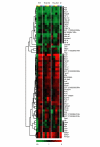Effects of ligand and thyroid hormone receptor isoforms on hepatic gene expression profiles of thyroid hormone receptor knockout mice
- PMID: 12776178
- PMCID: PMC1319202
- DOI: 10.1038/sj.embor.embor862
Effects of ligand and thyroid hormone receptor isoforms on hepatic gene expression profiles of thyroid hormone receptor knockout mice
Abstract
Little is known about the overall patterns of thyroid hormone (Th)-mediated gene regulation by the main Th receptor (Tr) isoforms, Tr-alpha and Tr-beta, in vivo. We used 48 complementary DNA microarrays to examine hepatic gene expression profiles of wild-type and Thra and Thrb knockout mice under different Th conditions: no treatment, treatment with 3,3',5-triiodothyronine (T(3)), Th-deprivation using propylthiouracil (PTU), and treatment with a combination of PTU and T(3). Hierarchical clustering analyses showed that positively regulated genes fit into three main expression patterns. In addition, only a subpopulation of target genes repressed basal transcription in the absence of ligand. Interestingly, Thra and Thrb knockout mice showed similar gene expression patterns to wild-type mice, suggesting that these isoforms co-regulate most hepatic target genes. Differences in the gene expression patterns of Thra/Thrb double-knockout mice and Th-deprived wild-type mice show that absence of receptor and of hormone can have different effects. This large-scale study of hormonal regulation reveals the functions of Th and of Tr isoforms in the regulation of gene expression patterns.
Figures





Similar articles
-
Thyroid hormone receptor Thra and Thrb knockout differentially affects osteoblast biology and thyroid hormone responsiveness in vitro.J Cell Biochem. 2023 Dec;124(12):1948-1960. doi: 10.1002/jcb.30500. Epub 2023 Nov 22. J Cell Biochem. 2023. PMID: 37992217
-
[Thyroid hormone and its receptors: have mouse genetics clarified the situation?].J Soc Biol. 2008;202(2):67-71. doi: 10.1051/jbio:2008008. Epub 2008 Jun 13. J Soc Biol. 2008. PMID: 18547502 French.
-
Regulation of expression of thyroid hormone receptor isoforms and coactivators in liver and heart by thyroid hormone.Mol Cell Endocrinol. 2003 May 30;203(1-2):65-75. doi: 10.1016/s0303-7207(03)00122-9. Mol Cell Endocrinol. 2003. PMID: 12782404
-
Use of a new model of transgenic mice to clarify the respective functions of thyroid hormone receptors in vivo.Heart Fail Rev. 2010 Mar;15(2):117-20. doi: 10.1007/s10741-008-9121-y. Epub 2009 Jan 10. Heart Fail Rev. 2010. PMID: 19137427 Review.
-
Thyroid hormone receptor mutations and disease: beyond thyroid hormone resistance.Trends Endocrinol Metab. 2005 May-Jun;16(4):176-82. doi: 10.1016/j.tem.2005.03.008. Trends Endocrinol Metab. 2005. PMID: 15860414 Review.
Cited by
-
Isoform-specific transcriptional activity of overlapping target genes that respond to thyroid hormone receptors alpha1 and beta1.Mol Endocrinol. 2009 Nov;23(11):1758-75. doi: 10.1210/me.2009-0025. Epub 2009 Jul 23. Mol Endocrinol. 2009. PMID: 19628582 Free PMC article.
-
Similarities and differences between two modes of antagonism of the thyroid hormone receptor.ACS Chem Biol. 2011 Oct 21;6(10):1096-106. doi: 10.1021/cb200092v. Epub 2011 Aug 15. ACS Chem Biol. 2011. PMID: 21815645 Free PMC article.
-
Thyroid Hormone Receptor α Regulates Autophagy, Mitochondrial Biogenesis, and Fatty Acid Use in Skeletal Muscle.Endocrinology. 2021 Aug 1;162(8):bqab112. doi: 10.1210/endocr/bqab112. Endocrinology. 2021. PMID: 34086893 Free PMC article.
-
Aldose Reductase Acts as a Selective Derepressor of PPARγ and the Retinoic Acid Receptor.Cell Rep. 2016 Apr 5;15(1):181-196. doi: 10.1016/j.celrep.2016.02.086. Epub 2016 Mar 24. Cell Rep. 2016. PMID: 27052179 Free PMC article.
-
Thyroid Hormone Signaling in Retinal Development and Function: Implications for Diabetic Retinopathy and Age-Related Macular Degeneration.Int J Mol Sci. 2024 Jul 4;25(13):7364. doi: 10.3390/ijms25137364. Int J Mol Sci. 2024. PMID: 39000471 Free PMC article. Review.
References
-
- Burke L.J. & Baniahmad A. (2000) Co-repressors 2000. FASEB J., 14, 1876–1888. - PubMed
-
- Chen Y., Kamat V., Dougherty E.R., Bittner M.L., Meltzer P.S. & Trent J.M. (2002) Ratio statistics of gene expression levels and applications to microarray data analysis. Bioinformatics, 18, 1207–1215. - PubMed
-
- Feng X., Jiang Y., Meltzer P. & Yen P.M. (2000) Thyroid hormone regulation of hepatic genes in vivo detected by complementary DNA microarray. Mol. Endocrinol., 14, 947–955. - PubMed
-
- Flamant F., Poguet A.L., Plateroti M., Chassande O., Gauthier K., Streichenberger N., Mansouri A. & Samarut J. (2002) Congenital hypothyroid Pax8−/− mutant mice can be rescued by inactivating the TRα gene. Mol. Endocrinol., 16, 24–32. - PubMed
-
- Flamant F. & Samarut J. (2003) Thyroid hormone receptors: lessons from knockout and knock-in mice. Trends Endocrinol. Metab., 14, 85–90. - PubMed
Publication types
MeSH terms
Substances
Grants and funding
LinkOut - more resources
Full Text Sources
Molecular Biology Databases

